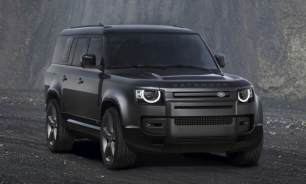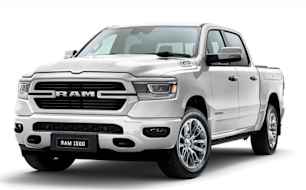With its hefty 2642kg kerb weight and 3505kg GVM, our test vehicle has an 863kg payload rating, which is modest when compared to numerous smaller utes with higher ratings.
It’s also rated to tow up to 3500kg on a 50mm tow-ball and up to 4500kg on a 70mm ball. And with its 7711kg GCM rating (or how much it can legally carry and tow at the same time) it can carry its maximum payload when towing 3500kg.
However, the payload must be reduced by almost 300kg to tow the maximum 4500kg, which would only leave about half a tonne of payload most of which could be used up by the weight of a full crew, so it’s important to be aware of these numbers if planning to tow that heavy.
The load tub is 1702mm long, 1270mm wide and 543mm deep, resulting in 1.5 cubic metres of total load volume and enough space between the sidewalls to carry either an Aussie or Euro pallet.
Lockable RamBox storage compartments on each side have a combined load volume of 420 litres and given both are equipped with rubber plug-sealed drain holes they are tailor-made for carting lots of ice and cold drinks.
A two-way powered tailgate saves a lot of physical effort and the load tub is protected by a spray-in liner. There are fixed load-anchorage points front and rear near floor level and slide-adjustable hooks near the top of the tub, so loads of all heights are catered for.
The tub also has internal lighting and its folding soft tonneau cover is easy to remove and refit. There’s also a spring-loaded step which swings down to ease rear load-tub access and when retracted is largely hidden behind the left rear wheel. Our test vehicle was also supplied with a sturdy and adjustable partition that can divide the load tub into two compartments.
Driver and front passenger enjoy spacious comfort, which is shared with rear passengers thanks to doors than swing wide open to access a plush bench seat that offers palatial head, knee and foot room even for tall people.
The cabin’s vast rear floor is also flat which ensures even a tall middle passenger can be comfortable on longer journeys without having to straddle a transmission tunnel.
There’s heaps of cabin storage available, starting with a big bin in the base of each front door plus a large glovebox on the passenger side.
The centre console, in addition to its twin wireless phone chargers, single HDMI and multiple USB ports, houses a huge storage box topped by a padded lid/elbow rest and an internal sliding tray equipped with two small-bottle/cup-holders.
Rear passengers also get storage bins in the doors plus pockets on each front seat backrest. The rear of the centre console, in addition to adjustable vents, seat heating controls and multiple USB ports has two small-bottle/cup holders for rear passenger use.
The 60/40-split bench seat’s base cushions can swing up and be stored vertically if you want more internal carrying space, or to access two storage compartments underneath. Plus there’s storage bins with removable liners underneath the floor on each side.
The centre seat’s backrest also folds forward to reveal a large centre console for two, which offers yet another pair of small-bottle/cup-holders. Its padded lid is wide enough to provide elbow rests for both sides and when raised reveals a storage tray ideal for storing phones or tablets.





